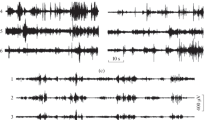Abstract
Qualitative asessments of general movements have been shown to have considerable power in predicting neurological outcomes in preterm infants with brain damage. In the present study such assessments were made in 35 preterm infants without major neurological problems before term age, born between 27 and 34 weeks gestation, of whom 12 were small-for-gestational-age (SGA). Most infants maintained a normal or (mildly) abnormal quality from 35 weeks postmenstrual age through 6, 12, 18 to 24 weeks corrected age. Seven changed from initially abnormal movements to a normal quality, six of them after 12 weeks. Differences between SGA and appropriate-for-gestational-age infants became less evident with age, particularly after 12 weeks. This was not the case when comparisons were made on the basis of gestational ages below or above 32 weeks. The prediction of neurological and mental outcomes at 1 year also improved after 12 weeks, around which age a major transformation in neural functions occurs. It is concluded that assessments of movement quality are particularly successful in predicting abnormal outcomes in comparison to examinations based on muscle tone and elicited responses.
Similar content being viewed by others
Abbreviations
- AGA:
-
appropriate-for-gestational-age
- GMs:
-
general movements
- SGA:
-
small-for-gestational age
References
Allen MC (1984) Developmental outcome and follow-up of the SGA infant. Semin Perinatol 8:123–156
Blair E, Stanley F (1990) Intrauterine growth and spastic cerebral palsy. I. Association with birth weight for gestational age. Am J Obstet Gynecol 162:229–237
Cioni G, Prechtl HFR (1990) Preterm and early postterm motor behaviour in low-risk premature infants. Early Hum Dev 23:159–191
Commey JOO, Fitzhardinge PM (1979) Handicap in the preterm small-for-gestational age infant. J Pediatr 94:779–786
Dubowitz L, Dubowitz V (1981) The neurological assessment of the preterm and fullterm newborn infant. Clinics in developmental medicine, vol 79. Spastics Int Med Publ
Ellenberg JH, Nelson KB (1981) Early recognition of infants at high risk for cerebal palsy: Examination at age four months. Dev Med Child Neurol 23:705–716
Ferrari F, Cioni G, Prechtl HFR (1990) Qualitative changes of general movements in preterm infants with brain lesions. Early Hum Dev 23:193–231
Frankenburg WK, Chen J, Thornton SM (1988) Common pitfalls in the evaluation of developmental screening tests. J Pediatr 113:1110–1113
Georgieff MK, Sasanow SR, Mammel MC, Pereira GR (1986) Mid-arm circumference/head circumference ratios for identification of symptomatic LGA, AGA and SGA newborn infants. J Pediatr 109:316–321
Hadders-Algra M, Huisjes HJ, Touwen BCL (1988) Preterm or small-for-gestational-age infants. Eur J Pediatr 147:460–467
Heinonen K, Matilainen R, Koski H, Launiali K (1985) Intrauterine growth retardation (IUGR) in preterm infants. J Perinat Med 13:171–178
Hopkins B, Prechtl HFR (1984) A qualitative approach to the development of movements during early infancy. In: Prechtl HFR (ed) Continuity of neural functions from prenatal to postnatal life. Clinics in develomental medicine, vol. 94. Blackwell, Oxford, pp 179–197
Kloosterman GH (1970) On intrauterine growth. Int J Gynaec Obstet 8:895–912
Largo RH, Pfister D, Molinari L, Kundu S, Lipp A, Duc G (1989) Significance of prenatal, perinatal and postnatal factors in the development of AGA preterm infants at five to seven years. Dev Med Child Neurol 31:440–456
Low JA, Galbraith RS, Muir DW, Broekhoven LH, Wilkinson JW, Karchmar EJ (1985) The contribution of fetal-newborn complications to motor and cognitive deficits. Dev Med Child Neurol 27:578–587
Luthy DA, Shy KK, Strickland D, Wilson J, Bennett FC, Brown ZA, Benedetti TJ (1987) Status of infants at birth and risk for adverse neonatal events and long-term sequelae: A study in low birthweight infants. Am J Obstet Gynecol 157: 676–679
Marlow N, Roberts BL, Cooke RWI (1989) Motor skills in extremely low birthweight children at the age of 6 years. Arch Dis Child 64:839–847
Meulen BF van der, Smrkovsky M (1984) Bayley developmental scales. Kinderstudies, Groningen (in Dutch)
Miller HC, Hassanein K (1971) Diagnosis of impaired fetal growth in newborn infants. Pediatr 48:511–522
Pena IC, Teberg AJ, Finello KM (1988) The premature smallfor-gestational-age infant during the first year of life: Comparison by birth weight and gestational age. J Pediatr 113:1066–1073
Prechtl HFR (1984) Continuity and change in early neural development. In: Prechtl HFR (ed) Continuity of neural functions from prenatal to postnatal life. Clinics in developmental medicine, vol. 94. Blackwell, Oxford, pp 1–15
Prechtl HFR (1984) Epilogue. In: Prechtl HFR (ed) Continuity of neural functions from prenatal to postnatal life. Clinics in developmental medicine vol. 94. Blackwell, Oxford, pp 245–247
Prechtl HFR (1986) Frühe Schäden — späte Folgen; Neuere Erkenntnise aus Nachuntersuchungen von Kindern. In: Schmidt MJ, Droemann S (eds) Langzeitverlauf Kinder und Jugendpsychiatrischer Erkrankungen. Ferdinand Enke Verlag, Stuttgart, pp 15–21
Prechtl HFR (1990) Qualitative changes of spontaneous movements in fetus and preterm infant are a marker of neurological dysfunction. Early Hum Dev 23:151–158
Prechtl HFR, Nolte R (1984) Motor behaviour in preterm infants. In: Prechtl HFR (ed) Continuity of neural functions from prenatal to postnatal Life. Clinics in developmental medicine vol. 94. Blackwell, Oxford, pp 79–92
Ross G, Lipper E, Auld PAM (1986) Early predictors of neurodevelopmental outcome of very low-birthweight infants at three years. Dev Med Child Neurol 28:171–179
Saint-Anne Dargassies S (1977) Neurological development in the fullterm and premature infant. Elsevier, Amsterdam
Stewart A, Hope PL, Hamilton P, Costello AM de-L, Baudin J, Bradford B, Amiel-Tison C, Reynolds EOR (1988) Prediction in very preterm infants of satisfactory neurodevelopmental progress at 12 months. Dev Med Child Neurol 30:53–63
Touwen BCL (1976) Neurological development in infancy. London, Heinemann
Author information
Authors and Affiliations
Rights and permissions
About this article
Cite this article
Geerdink, J.J., Hopkins, B. Qualitative changes in general movements and their prognostic value in preterm infants. Eur J Pediatr 152, 362–367 (1993). https://doi.org/10.1007/BF01956755
Received:
Accepted:
Issue Date:
DOI: https://doi.org/10.1007/BF01956755




